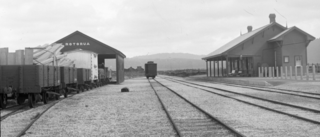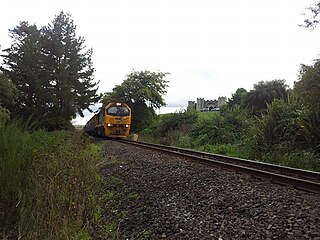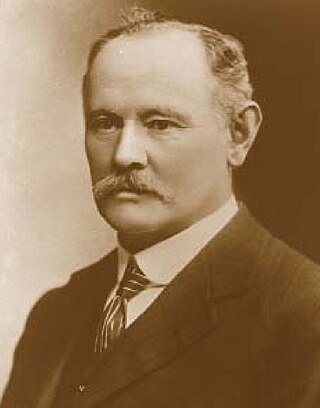Related Research Articles

Waikato is a region of the upper North Island of New Zealand. It covers the Waikato District, Waipa District, Matamata-Piako District, South Waikato District and Hamilton City, as well as Hauraki, Coromandel Peninsula, the northern King Country, much of the Taupō District, and parts of the Rotorua Lakes District. It is governed by the Waikato Regional Council.
Tokoroa is the fifth-largest town in the Waikato region of the North Island of New Zealand and largest settlement in the South Waikato District. Located 30 km southwest of Rotorua and 20 km south of Putāruru, close to the foot of the Mamaku Ranges, it is midway between Taupō and Hamilton on State Highway 1.

Tīrau is a small town in the Waikato region of the North Island of New Zealand, 50 kilometres southeast of Hamilton. The town has a population of 804. In the Māori language, "Tīrau" means "place of many cabbage trees."

South Waikato District is a local government district in the Waikato Region of the North Island of New Zealand. It is located between the cities of Hamilton to the north, Rotorua to the east, Taupo to the south and Ruapehu District to the west.

Putāruru is a small town in the South Waikato District and the Waikato region of New Zealand's North Island. It lies on the western side of the Mamaku Ranges and in the upper basin of the Waihou River. It is on the Oraka Stream 65 kilometres south-east of Hamilton. State Highway 1 and the Kinleith Branch railway run through the town.

The International Concatenated Order of Hoo-Hoo, Incorporated is a fraternal and service organization whose members are involved in the forests products industry. Hoo-Hoo has members in the United States, Canada, Australia, New Zealand, Malaysia and South Africa.

Arapuni is a rural town centre on the Waikato river in the South Waikato District of New Zealand. The town sits next to the Arapuni Dam, a hydroelectric dam at Lake Arapuni commissioned in 1929. The Arapuni Power Station consists of eight turbines which give a total output of 196 MW, the largest of the power stations on the Waikato river. The Arapuni hydro station is owned and operated by Mercury Energy.

Waikato Museum is a regional museum located in Hamilton, New Zealand. The museum manages ArtsPost, a shop and gallery space for New Zealand art and design. Both are managed by the Hamilton City Council. Outside the museum is The Tongue of The Dog, a sculpture by Michael Parekōwhai that has helped to increase visitor numbers. The sculpture was commissioned by MESH Sculpture Trust, Hamilton.
There have been a number of proposals to build a Taupō Line as a branch railway linking the township of Taupō in the central North Island of New Zealand to New Zealand's rail network. One proposal proceeded as far as the construction stage before being stopped.
Rotowaro was once a small coal mining township approximately 10 km west of Huntly in the Waikato region of New Zealand. The town was built especially for miners houses, but was entirely removed in the 1980s to make way for a large opencast mine.

Taupō is a New Zealand parliamentary electorate returning one Member of Parliament to the House of Representatives. Taupo first existed between 1963 and 1981, and was recreated for the introduction of MMP in 1996. The current MP for Taupō is Louise Upston of the National Party. She has held this position since 2008.

The Rotorua Branch is a railway line from Putāruru to Rotorua, in the Waikato and Bay of Plenty regions of the North Island of New Zealand. Construction of the line was commenced by the Thames Valley and Rotorua Railway Company and finished by the Public Works Department (PWD). The complete line, 50.5 kilometres (31.4 mi) in length, opened in two sections; on 24 November 1893 to Tārukenga and the final 8 mi 43 ch (13.7 km) to Rotorua on 8 December 1894.

The Kinleith Branch railway line is located in the Waikato region of New Zealand. The line was constructed by the Thames Valley and Rotorua Railway Company, Taupo Totara Timber Company and rebuilt by the Public Works Department primarily to serve the Kinleith Mill in 1952. It is 65 kilometres (40 mi) in length.

John William Ellis MBE was a New Zealand businessman and mayor of Hamilton from 1917 to 1918.

Ellis and Burnand was a New Zealand sawmilling and timber retailing company, formed by businessman John William Ellis and engineer Harry Burnand in 1891.

The Mokai Tramway was a bush tramway constructed by the Taupo Totara Timber Company to link their milling centre at Mokai with the New Zealand Government Railways line (NZR) at Putāruru in the Waikato region on the North Island of New Zealand. The more than 82 kilometres (51 mi) long light railway line was operated from 1903 to 1944 by the Taupo Totara Timber Company Tramway. It was handed over to NZR on 12 June 1950, and the section from Putāruru to Kinleith Mill south of Tokoroa is still being used for goods transport as of 2018.
Lichfield is a rural settlement in the South Waikato District and Waikato region of New Zealand's North Island.
Waimiha is a rural community in the Ruapehu District and Manawatū-Whanganui region of New Zealand's North Island.
Wharepapa South is a rural community in the Waipa District and Waikato region of New Zealand's North Island. It is located west of Putāruru and east of Te Awamutu.
Jane Yandle was a professional furrier and taxidermist noted for her taxidermy of New Zealand birds, some of which are still on museum display more than 100 years after her death.
References
- ↑ "New Zealand Timber Museum". nztimber.co.nz. Retrieved 3 August 2020.
- 1 2 A History of Putaruru and Districts. Putaruru, New Zealand: Putaruru Timber Museum. 1986. pp. 47–48.
- 1 2 "Putaruru Museum looks to the future". New Zealand Logger Magazine: 36–38. November 2011.
- ↑ "Timber Museum looks to the future". Waikato Times. 15 October 2018. Retrieved 18 August 2020.
- ↑ ""International timber club opens South Waikato base"". Waikato Times. 30 April 2019. Retrieved 3 August 2020.
- ↑ "Our Family Genealogy List". September 2012. Retrieved 3 August 2020.